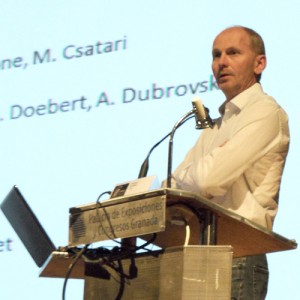The forces behind the two most mature proposals for a next-generation collider, the International Linear Collider (ILC) and the Compact Linear Collider (CLIC) study, have been steadily coming together, with scientists from both communities sharing ideas and information across the technology divide. In at least nominal support of cooperation between the two, CERN in Switzerland, where most CLIC research takes place, recently converted the project-specific position of CLIC Study Leader to the concept-based Linear Collider Study Leader.
The scientist who now holds this position, Steinar Stapnes, is charged with making the linear collider a viable option for CERN’s future, one that could include either CLIC or the ILC. The transition to more involve the ILC must be gradual, he said, and the redefinition of his post is a good start. Though not very much involved with superconducting radiofrequency (SRF) technology, where ILC researchers have made significant advances, CERN participates in many aspects of ILC-related studies through combined working groups, site studies and detector and physics activities.
“Now, over the next year, we will have a new Linear Collider organisation that provides a common discussion base, more than before,” Stapnes said. At the end of this year, CLIC completes its Conceptual Design Report. After that comes the fulfillment of the ILC mission, the delivery of its Technical Design Report (TDR) at the end of 2012. The linear collider leaders are still discussing and deciding the shape of the post-2012 linear collider community.
“Short-term decisions involve what CERN can do to help with the TDR,” he said.
CERN’s inertia in linear collider research is firmly with CLIC, and so as Stapnes looks for solutions to help with ILC-related research at the Swiss laboratory, he also takes care not to undermine the work of the hundred or so researchers that invest their energies in CLIC and that are now moving into next phase of CLIC project development.
Initially the two projects’ working groups will look for existing technological problems at CLIC where further investigation would benefit both colliders, whose primary difference is in the technology used to accelerate the beam. The ILC uses cold, superconducting cavities to propel particles to collision. CLIC uses warm, normal-conducting structures.
“In many cases there’s the possibility of saying, ‘Don’t just look at the CLIC parameters, but work with ILC on a different set of parameters – think on both projects’,” he said. Areas of potentially overlapping interests between both projects include damping rings, positron sources, beam delivery systems, machine-detector interface and detector and physics studies. “In practice one has to look case by case to identify where tighter collaboration and more combined activities could help, and also where groups can work constructively together.”

The second conference held jointly by ILC and CLIC collaborations was held this year in Granada, Spain.
Taking advantage of technological challenges common to both projects is a manageable way for CERN to participate in the ILC design in the short term, Stapnes said.
Full integration of the two design teams in the run-up to the TDR, on the other hand, is unrealistic and not the aim of CERN’s near-term linear collider programme. CLIC is a well established project at CERN, one that currently commands almost the full extent of resources for linear collider work. Stapnes is clear that CERN’s resources on the ILC side are thin. Further, tapping into CERN’s SRF technology R&D hasn’t been a priority for a collider that uses normal conductivity. Developing an SRF programme now means subtracting resources from other programmes at the lab. Plus, one can’t easily forget that the LHC remains the highest-priority project at the laboratory and its operation and gradual improvements require substantial resources.
“In the plan for CERN till 2016, there’s no increase of personnel resources. You can only squeeze so hard,” he said. “This can change. If there’s really a clear discovery from the LHC indicating that a linear collider is the way to go, one could imagine a situation where more resources are available.”
The situation is a bit different for detector research. The SiD (Silicon Detector) and ILD (International Large Detector) groups, who originally developed the models for the ILC, have for the past couple of years been involved in designing different detector versions to accommodate CLIC’s particular beam structure and higher energies. In this area, cooperation is natural since the demands on the ILC and CLIC detectors are not fundamentally different.
“For that part, in extremely close collaboration, we’re relying on a lot of the work for ILC’s SiD and ILD concepts for detectors,” Stapnes said.
As for the accelerating machines, over the next three to five years the combined working groups between ILC and CLIC could more actively define research directions that would aid both colliders. In addition, CERN could examine how its infrastructure could facilitate cryomodule assembly, which would boost both its own SRF programme and help the ILC.
“So there are some contributions, not big, but significant contributions where CERN has a lot of expertise, and these could be studied to see how could CERN be a part of a global linear collider project and make the most effective contributions, which also benefit the ILC option more than before,” Stapnes said. “It is the ambition of CERN to be an important part of a future linear collider project.”
Ideally, concrete contributions will help CERN and CLIC, as well as the ILC, as much as possible, he says. “It says clearly that CERN, or Europe through CERN, is willing and interested in participating in pulling our share of such a project – whatever this share ultimately is and whenever it becomes real.”


Recent Comments